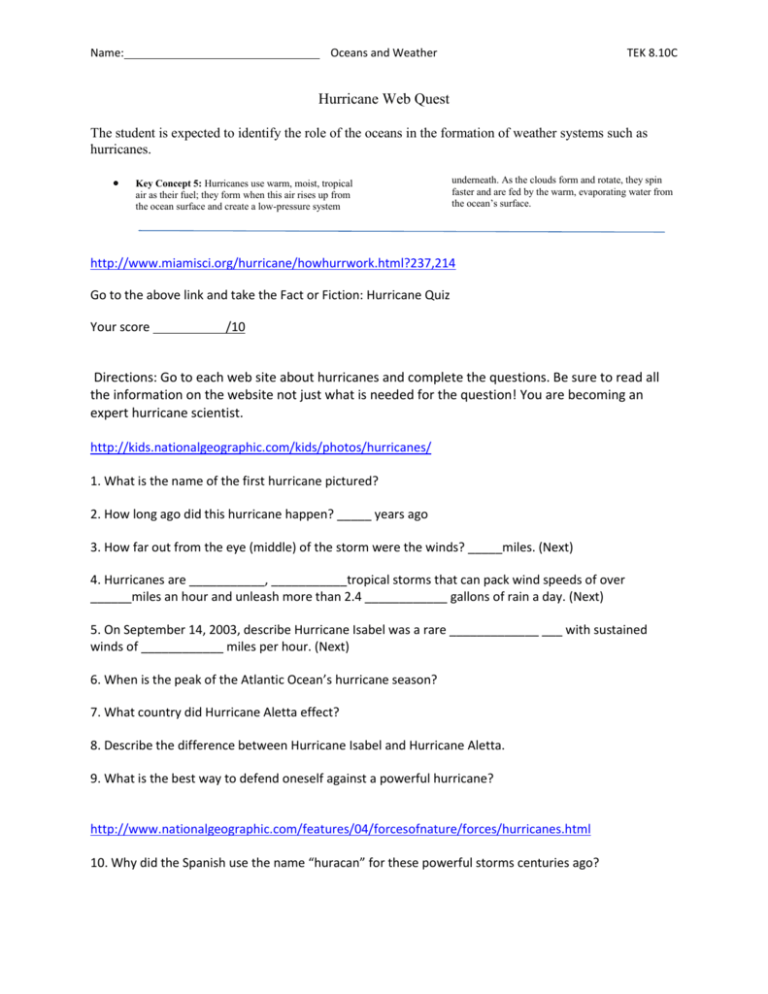Hurricane Web Quest
advertisement

Name: Oceans and Weather TEK 8.10C Hurricane Web Quest The student is expected to identify the role of the oceans in the formation of weather systems such as hurricanes. Key Concept 5: Hurricanes use warm, moist, tropical air as their fuel; they form when this air rises up from the ocean surface and create a low-pressure system underneath. As the clouds form and rotate, they spin faster and are fed by the warm, evaporating water from the ocean’s surface. http://www.miamisci.org/hurricane/howhurrwork.html?237,214 Go to the above link and take the Fact or Fiction: Hurricane Quiz Your score /10 Directions: Go to each web site about hurricanes and complete the questions. Be sure to read all the information on the website not just what is needed for the question! You are becoming an expert hurricane scientist. http://kids.nationalgeographic.com/kids/photos/hurricanes/ 1. What is the name of the first hurricane pictured? 2. How long ago did this hurricane happen? _____ years ago 3. How far out from the eye (middle) of the storm were the winds? _____miles. (Next) 4. Hurricanes are ___________, ___________tropical storms that can pack wind speeds of over ______miles an hour and unleash more than 2.4 ____________ gallons of rain a day. (Next) 5. On September 14, 2003, describe Hurricane Isabel was a rare _____________ ___ with sustained winds of ____________ miles per hour. (Next) 6. When is the peak of the Atlantic Ocean’s hurricane season? 7. What country did Hurricane Aletta effect? 8. Describe the difference between Hurricane Isabel and Hurricane Aletta. 9. What is the best way to defend oneself against a powerful hurricane? http://www.nationalgeographic.com/features/04/forcesofnature/forces/hurricanes.html 10. Why did the Spanish use the name “huracan” for these powerful storms centuries ago? Name: Oceans and Weather TEK 8.10C 11. Today, how is it determined if a storm is a hurricane or not? 12. What are the three different names for these big storms over the ocean and where in the world are they located? _________________________ formed in _____________________________________________ _________________________ formed in ______________________________________________ _________________________ formed in ______________________________________________ 13. How many tropical disturbances form each year? _______ What percentage of them become more than thunderstorms? _________% 14. Off of what continent do hurricanes begin? ____________________ 15. Describe how they get their energy. 16. When is the storm given a name? 17. When is it determined to be a hurricane? 18. Name and describe the three main parts of the hurricane. http://spaceplace.nasa.gov/hurricanes/ 19. Why are the ocean storms like giant engines? 20. Illustrate the cross section of a tropical cyclone. Label high and low pressure on your illustration. Name: Oceans and Weather TEK 8.10C 21. What direction do the winds blow? 22. What can the hurricane’s heavy rains cause? _____________________, ________________ and __________________ ________________. 23. What is the most dangerous part of the hurricane? ________________ __________________ http://www.nhc.noaa.gov/aboutnames.shtml 24. Spell your name phonetically with the 2017 Atlantic Names Example Jennifer would be Jose, Emily, Nate, Nate, Irma, Franklin, Emily and Rina 25. Can you have a tropical storm named for you? 26. Why are storm name removed from the list? http://www.nhc.noaa.gov/surge/ 27. What kind of damage can a hurricane’s winds cause? 28. 9 out of 10 deaths during a hurricane are due to storm surge. Describe the damage storm surge causes. 29. Describe two storms where storm surge was the main killer. Include when and where the storms happened. http://www.403wg.afrc.af.mil/library/factsheets/factsheet.asp?id=7483 or http://www.hurricanehunters.com/ 30. Who are “Hurricane Hunters”? 31. Describe what they do in no more than 3 sentences. Name: Oceans and Weather TEK 8.10C 32. Why is it necessary to fly into a hurricane’s clouds? 33. What information do they collect? http://www.ready.gov/hurricanes 34. What are the differences between and hurricane watch and a hurricane warning? 35. Why is it important for you to know about hurricanes? http://www.miamisci.org/hurricane/howhurrwork.html?237,214 36. What fuels (powers) a hurricane? 37. Why do you think a hurricane only forms over water and looses power over land? 38. What do the colors in the radar stand for? Be specific! 39. Click on “Hurricane Diagram”. Describe the most powerful part of the storm. 40. Where is the calmest part of the storm? 41. What do you think are the 5 most important things on the Hurricane Shopping List? Explain why you think each is MORE important than the other things on the list.




